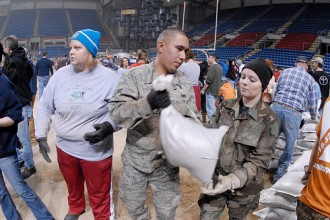
Last spring a fascinating little story in the LA Times on the collective/behaviorial intelligence of fire ants put me in mind of the Harvard sociobiologist E.O. Wilson (“Fire Ants for Sociology”). I first heard about Wilson in high school (his paradigm-shifting book came out in 1979; I graduated in 1985), read some of his work in college, and talked about it a fair bit hanging out with biologists in graduate school, but I hadn’t thought a lot about him and his ideas since.
Wilson, I learned from a recent New Yorker piece on the genetics of altruism, hasn’t been hiding or anything. Though now over 80 years old, Wilson is still as busy as the ants (too bad, for alliterative purposes, it wasn’t bees) he’s spent his life studying. Indeed, among his numerous accomplishments of last 20 years is a massive, richly (and apparently hand-) illustrated, 800-page book on Pheidole, the “most abundant genus of ants.”
The article in the New Yorker is actually not about Wilson, though, so much as a whole debate that has taken shape within his field. It centers on natural selection and the existence of altruism and cooperation. More specifically, it is about the validity of William Hamilton’s “inclusive fitness theory,” which posited that the Darwinian concept of competitive fitness was driven not only by how many offspring an individual manages to have, but also about the reproductive capabilities of surviving relatives. At the core of the controversy is the validity and utility of the elegant mathematical formula from and upon which Hamilton derived his theory in the 1960s.
For several decades now, the equation—which which I won’t detail here—has held essentially biblical status for explaining genes and cooperation. According to the story, Oxford biologist Richard Dawkins called Hamilton “the most distinguished Darwinian since Darwin.” But a new generation of biologists are challenging the formula on mathematical grounds; they have joined forces with Wilson, whose own doubts stem from his voluminous knowledge and observations of insects. Wilson now says his embrace of Hamilton’s math was misguided: “I’m going to be blunt,” he told the New Yorker. “The equation doesn’t work. It’s a phantom measure.”
This article is a model of science reporting (and sociology of science type insight), with fascinating details about how an idea emerges and takes hold of a field, the relationship between mathematical modeling and empirical observation in the biological sciences, and the social nature of the development of scientific knowledge. The latter isn’t always pretty: the insurgents have weathered a storm of both public and private virulent criticism. It is, as reporter Jonah Lehrer nicely characterizes it, “science with existential stakes.”
Still, for my money, the Wilson parts of the story are the most compelling. Wilson, after all, is the one who helped make Hamilton’s equation famous; now he’s leading the charge against the theorem, and he seems to relish the attention and controversy. Perhaps I’m a sucker for the drama and intrigue of the renegade scholar. But at a more intellectual level, what I find appealing is Wilson’s insistence that “human generosity might have evolved as an emergent property not of the individual but of the group.”
“Group selection” is apparently dismissed by most evolutionary biologists, but Wilson believes it holds the key to understanding altruism. “Goodness,” as the article explains, “might actually be an adaptive trait, allowing more cooperative groups to outcompete their conniving cousins.” Wilson cites cases of cooperation the animal kingdom ranging from microbes to plants and female lions. “In all of these studies, many of which have been conducted in the controlled conditions of the lab, clumps of cooperators thrive and replicate, while selfish groups wither and die.”
Lehrer goes on to quote a wonderful, concise bit from a 2007 Wilson paper: “Selfishness beats altruism within groups. Altruistic groups beat selfish groups. Everything else is commentary.”
I love those first two sentences. But as profound and compelling as I find them, the third gives me pause, reminding me of the difference between the straight biological sciences and the human sciences. My sense is that in the human domain it is precisely the tension between selfishness and altruism and the choices we make between ourselves and our collective commitments—Wilson’s “commentary”—that is most interesting and uncertain (not just theoretically, but in actual social life).
In my earlier post on Wilson and his ants, I wrote that a group or collective can develop complex systems to achieve things that no individual member could have imagined or enacted. In addition, I suggested humans have a unique ability and capacity to organize, structure, and reflect upon our collective activities. Indeed, in my view, self-conscious reflection is one of humans’ real sources of power and adaptability in the natural world. As both individuals and groups, we are constantly faced with choices about if and when to be self-interested or altruist, individualistic or cooperative. These are not easily summarized by mathematical equations. Nor, for that matter, are they fully structured and determined—which is why, as biological as we are and as much as the social sciences share with the hard sciences, important differences remain regarding what the significant questions are, how we act upon them, and what is only just commentary.

Comments 1
2012: Your TSP Favorites » The Editors' Desk — January 1, 2013
[...] Desk: “Altruism, Ants, and E.O. Wilson,” by Doug Hartmann (oddly edged out juuuust slightly by a post about my own editorial and [...]